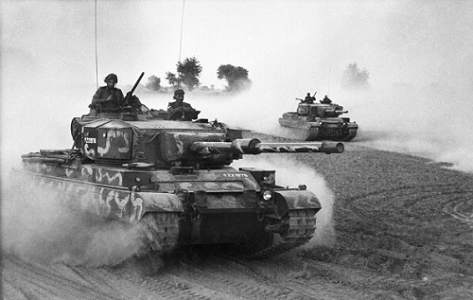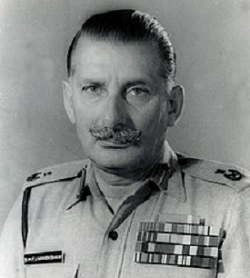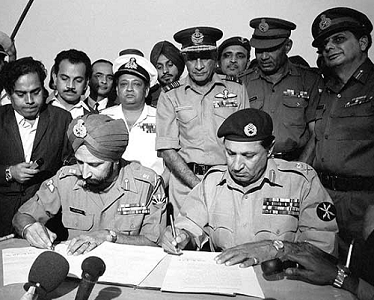Dec 28, 2025
Dec 28, 2025
by H.N. Bali
Unresolved Military-Civil Equation – Part IV
Continued from “The Man Who Exorcised the Specter of Coups”
Manekshaw and Redefinition of Civil-Military Equation

Indian history is no stranger to wars, and the destruction such visitations wreak on an unprepared nation. Many a marauder came devastating the land. Hordes of invaders like Mahmud Ghazni and Timur Lang and Ahmed Shah Abdali plundered the country. However, the last full-fledged war we fought in 1971 was different – altogether different. It was waged not to conquer but liberate a country. It was a war we can be legitimately proud of – a war resulting in total victory after which every Indian could say with pride: yes, we can – and will in the future – hit back mercilessly.
 It was also a war conducted with utmost planning and precision led by a man who will, for ever, have a legitimate place of honor for not just his professional skills as a soldier but also as a great patriot and a greater gentleman who lived up to the highest professional standards even when treated most shabbily after retirement by the political establishment of the day, and also bequeathed a new and iron-clad civil and military equation that sustains our polity.
It was also a war conducted with utmost planning and precision led by a man who will, for ever, have a legitimate place of honor for not just his professional skills as a soldier but also as a great patriot and a greater gentleman who lived up to the highest professional standards even when treated most shabbily after retirement by the political establishment of the day, and also bequeathed a new and iron-clad civil and military equation that sustains our polity.
A brief resume of what happened after the historic Cabinet meeting referred to in the last installment is necessary because it has a significant bearing to how the civil-military equation was refined for the future.
Redeeming the Honour
India won a glorious victory against Pakistan in the 1971 war. It was the first decisive victory in a major war in centuries. And it was won singlehandedly, in the face of opposition and threats from a majority of the UN member-States, including a superpower. Every Indian patriot felt proud of this glittering chapter in the nation’s history.
The above statement is by Dr S N Prasad in his introduction to the Indian government’s ‘restricted’ Official History of the 1971 War.
How did this happen? How was national honour redeemed after the 1962 humiliation?
“There is no reason why the Indian Army cannot rise again and give a much better account of itself. I hope when the day comes, it happens under my escutcheon.”
This was what Gen J N Chaudhuri wrote in a 40-page covering note while forwarding the Henderson Brooks-PS Bhagat report on the 1962 military debacle to the Defense Ministry. Yes, phoenix-like the Indian Army rose from the ashes of the 1962 war and gave, under Gen Makenshaw, a most creditable account of itself.
After the Prime Minister gave her go-ahead to Manekshaw as per his terms, the General plunged himself in action in right earnest. The Government took the decision to extend active support to the freedom movement in East Pakistan, led by Sheikh Mujibur Rehman. The task of training and equipping the Mukti Bahini, as the freedom fighters were known, was entrusted to the Indian Army, which trained and equipped three brigades of regular Bangladesh troops. Additionally, about 75,000 guerrillas were trained and equipped with weapons and ammunition. From the middle of 1971 till the end of the war, they operated in small bands, harassing the regular troops of the Pakistan Army. The Government of Bangladesh, as the new nation was intended to be named once it became independent, had started functioning in Calcutta and Colonel M.A.G. Osmani was appointed the Military Advisor and C-in-C of its Army.
As the atrocities committed by Tikka Khan’s troops in East Pakistan grew in intensity, so did the flood of refugees streaming into India. The international media, which initially viewed India's action in providing help to the Mukti Bahini as interference in the internal affairs of a neighbouring country, slowly began to veer round in India’s favour.
On the diplomatic front, the Government went all out to convince the world of the righteousness of India’s stand. Indira Gandhi visited several foreign countries and personally briefed the heads of governments. Except the Soviet Union, none of the major powers supported India’s stand. In fact, some were critical of her actions and the USA as well as China came out openly in support of Pakistan. Indira Gandhi, realising the threat of intervention by China as well as Pakistan, sent D.P. Dhar to Moscow with feelers regarding obtaining support from the Soviet Union. The Russians responded favourably and the Indo-Soviet Treaty of Peace, Friendship and Co-operation was signed on 9 August 1971. This was a major diplomatic achievement and effectively neutralised the threat from USA and Pakistan, giving India considerable leeway in deciding her course of action.
The strategy for the operations in East Pakistan as decided by Manekshaw was to mount a multi-pronged attack, bypassing strongly held areas, with the aim of capturing maximum territory in the shortest possible time. This was essential because of the possibility of a UN sponsored ceasefire after a few weeks. It was intended to liberate a large enough area to facilitate the establishment of a Bangladesh government. The capture of Dacca or the fall of the whole of East Pakistan was neither planned nor visualised to begin with. The task of executing the strategy formulated by Army HQ was given to Eastern Command, headed by Lt. General Jagjit Singh Aurora, who had Maj. General J.F.R. Jacob as his Chief of Staff.
The Indo Pak War of 1971 started on December 3, 1971, after Pakistani aircraft bombed Indian airfields in the Western sector. Indira Gandhi was then in Calcutta. Sam Manekshaw telephoned Jacob at 6 p.m. and asked him to inform the Prime Minister that the war had begun and he was issuing orders to Eastern Command to go ahead immediately. Characteristically, Manekshaw ‘informed’ the Prime Minister rather than seeking permission. Jacob informed the Army Commander, who left at once to brief the Prime Minister, who was staying with the Governor at Raj Bhawan. The Navy and Air Force were also informed and full scale operations commenced the next day.
As the operations progressed, Pakistani resistance broke down. The Indians bypassed all strongly held positions and the isolated Pakistani troops, taken by surprise, began to withdraw or surrender. American proposals to get the United Nations to effect a ceasefire were frustrated by the Soviets, who vetoed the resolutions. An interesting feature of the war was the three broadcasts made by Indian Army Chief, calling on Pakistani troops to surrender and assuring them of honourable treatment. The first message was broadcast on the radio and dropped in the form of leaflets after the fall of Jessore on 9 December. Addressed to the ‘officers and jawans of the Pakistan Army’, it exhorted them to lay down their arms, before it was too late. It went on to say: “Indian forces have surrounded you. Your Air Force is destroyed. You have no hope of any help from them. Chittagong, Chalna and Mangla ports are blocked. Nobody can reach you from the sea. Your fate is sealed. The Mukti Bahini and the people are all prepared to take revenge for the atrocities and cruelties you have committed.... Why waste lives? Don't you want to go home and be with your children? Do not lose time; there is no disgrace in laying down your arms to a soldier. We will give you the treatment befitting a soldier.”
Two other messages, on the same lines, were broadcast on December 11 and 15, in reply to messages from Major General Rao Farman Ali and Lt General A.K. Niazi. These messages were a severe blow to the morale of the Pakistani troops and convinced them of the futility of further resistance. Accounts of Pakistani officers and men captured, subsequently revealed that these messages had played a significant part in degrading Pakistani resolve to fight and it is estimated that they had shortened the war by at least two weeks.
On December 11, Major General Rao Farman Ali, the Military Adviser to the Governor of East Pakistan, sent a message to the United Nations asking for a ceasefire. The Security Council was about to begin discussing the message when another message was received from President Yayha Khan countermanding Farman Ali’s message, which it described as ‘unauthorised’.
On 14 December Yahya Khan sent instructions to Niazi to take action as he deemed fit to stop the fighting and preserve the lives of his men. Before this message reached Niazi, another development had taken place. Malik convened a meeting at mid-day, on 14 December at Government House in Dacca, to discuss the issue. The wireless message giving the time and venue of the meeting was intercepted by an Indian Signals interception unit. The Indian Air Force bombed the Government House, causing a lot of damage. Malik was badly shaken and his concern for the safety of his Austrian wife and daughter, who were with him, finally pushed him towards a decision. He immediately wrote out his resignation and accompanied by his cabinet and other civil servants, moved to Hotel Intercontinental, which had been occupied by the International Red Cross and was treated as a neutral zone.
The decision to surrender was actually taken by Niazi, who addressed a message to Sam Manekshaw on 15 December and requested the United States Consul General in Dacca, Herbert Spivack, to convey it to him. Around midnight, on December 15, Niazi sent a message to all his formation commanders to contact their Indian counterparts and negotiate a ceasefire. The war was over.

The formal surrender ceremony took place at Dacca on 16 December. In front of a large crowd, General Niazi handed over his pistol to Lt General Aurora, the Army Commander, and signed the Instrument of Surrender at 1655 Hours. Along with Niazi, about 93,000 Pakistani soldiers became prisoners of war. On 10 January 1972, Sheikh Mujib returned to Dacca in triumph and took over the reins of the Government of Bangladesh.
India, thus, won a decisive victory over Pakistan in 1971. A new nation had come into being and Manekshaw, as the prime architect of the victory, became a hero. Apart from capturing almost a hundred thousand prisoners, the Indian Army had occupied several hundred square kilometres of Pakistani soil in Ladakh.
After a year, when talks were held in Simla between the Prime Ministers of India and Pakistan. India could indeed have wrested major concessions from Pakistan and negotiated a permanent solution to the Kashmir problem. Manekshaw was kept out of the summit and had no part to play in the negotiations. Five Kashmiri Pandits – D P Dhar, P N Dhar, P N Haksar, T N Kaul and R N Kaw were Indira Gandhi’s advisers. As a result, all the military gains, achieved at great cost in human lives, were frittered away by politicians and bureaucrats. When Indira returned form Shimla, she told Manekshaw about the meeting. Bhutto had told her that he had recently taken over and was not in a position to take major decisions. He needed more time and promised that in six months everything would be done as she desired. Manekshaw reportedly told the Prime Minister: “Bhutto has made a monkey out of you.” (For once Sam Bahadhur was content with a mere euphemism!)
To be Continued
10-May-2013
More by : H.N. Bali

|
History tells us we do not learn lesson from the past. present government is no different. jinnah to nawaz sherif have been in opossition to India. treat them gently but hit them mercilessly. USA and Pakistan had been friends of necessity. Remember how Clinton dissuaded pakistan prime minister from nuclear use. and the kargil war: these are part of history. Pakistani taln never gets straight.. be on watch what pakistan does and keep hitting them hard now and then. Nawaz Sherif , treat him with chicken biryani and show him road to karachi or to peshawar where he belongs. |